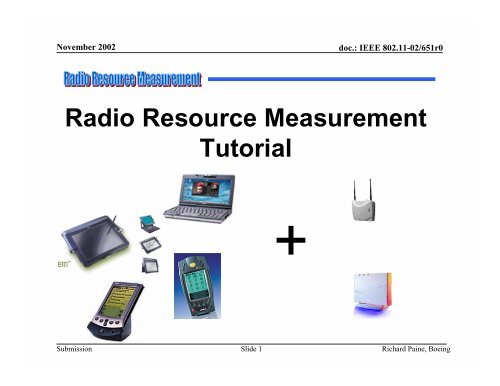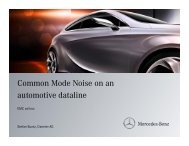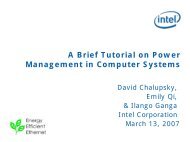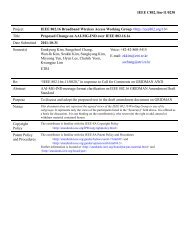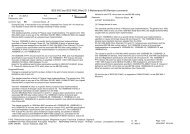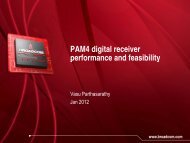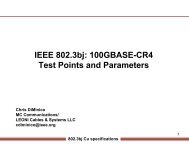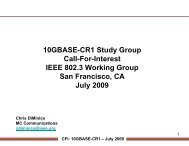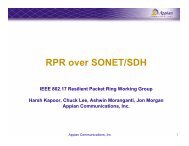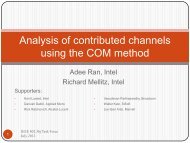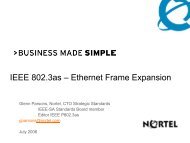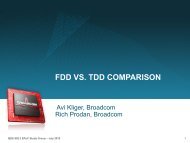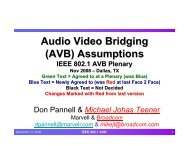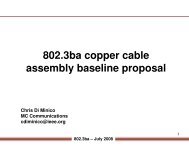Radio Resource Measurement Tutorial
Radio Resource Measurement Tutorial
Radio Resource Measurement Tutorial
You also want an ePaper? Increase the reach of your titles
YUMPU automatically turns print PDFs into web optimized ePapers that Google loves.
November 2002<br />
Slide 1<br />
doc.: IEEE 802.11-02/651r0<br />
<strong>Radio</strong> <strong>Resource</strong> <strong>Measurement</strong><br />
Submission<br />
<strong>Tutorial</strong><br />
Richard Paine, Boeing
November 2002<br />
Submission<br />
Slide 2<br />
Agenda<br />
- Why <strong>Radio</strong> <strong>Resource</strong> <strong>Measurement</strong> now?<br />
- 802.11 Existing <strong>Measurement</strong> Approach<br />
- Proposed Approach<br />
- Requirements<br />
-Issues<br />
- Futures<br />
- Conclusions<br />
doc.: IEEE 802.11-02/651r0<br />
Richard Paine, Boeing
November 2002<br />
Submission<br />
Slide 3<br />
doc.: IEEE 802.11-02/651r0<br />
RRM Extension Options<br />
RRM blue stars show the likely location of RRM extensions,<br />
though RRM pink stars are (remotely) possible.<br />
RRM Applications are outside the 802.11 specs.<br />
RRM<br />
RRM<br />
RRM<br />
MAC SAP<br />
MAC<br />
PHY SAP<br />
PLCP<br />
PMD SAP<br />
PMD<br />
MLME<br />
PLME SAP<br />
PLME<br />
RRM<br />
RRM<br />
MLME SAP<br />
PLME SAP<br />
RRM<br />
Applications<br />
(outside<br />
802.11)<br />
SME<br />
Richard Paine, Boeing
November 2002<br />
Submission<br />
Slide 4<br />
doc.: IEEE 802.11-02/651r0<br />
MIBs–current<br />
802.11<br />
– Basic measurements & configuration for STA<br />
– Widely implemented in APs<br />
– Very simple monitoring of global AP statistics<br />
802.1x<br />
– Detailed auth state for individual 1x ports<br />
– Also some per port statistics<br />
– Not widely implemented in access points today<br />
Bridge MIB<br />
– Possible to get some info on which STAs are associated with<br />
an AP<br />
– Implemented in some APs<br />
– Not 802.11 specific, little MAC, and no PHY statistics<br />
Richard Paine, Boeing
November 2002<br />
Submission<br />
Slide 5<br />
doc.: IEEE 802.11-02/651r0<br />
Work from existing TGs<br />
802.11d<br />
– dot11CountryString<br />
TGe<br />
– dot11AssociatedStationCount<br />
– dot11ChannelUtilization<br />
– dot11FrameLossRate<br />
TGi<br />
– Write only key access, & IV status<br />
TGh<br />
– Configuration, but no status, monitoring or<br />
statistics!!!<br />
Richard Paine, Boeing
November 2002<br />
Submission<br />
Slide 6<br />
doc.: IEEE 802.11-02/651r0<br />
Purpose of additions<br />
Enable better diagnostics of problems<br />
– Using info that is easy and cheap to gather<br />
Enable better frequency planning,<br />
optimize network performance<br />
– Enable automatic frequency planning<br />
Enable new services<br />
– Location based services<br />
Richard Paine, Boeing
November 2002<br />
Submission<br />
Slide 7<br />
doc.: IEEE 802.11-02/651r0<br />
Diagnostics<br />
Interference from non 802.11 sources<br />
Interference from other 802.11 networks<br />
Interference from other APs within same<br />
ESS<br />
Richard Paine, Boeing
November 2002<br />
Submission<br />
Slide 8<br />
doc.: IEEE 802.11-02/651r0<br />
Add Station Table to MIB<br />
Station table is list of wireless STAs an<br />
AP knows about<br />
Also applicable to IBSS<br />
Currently implemented by many APs, as<br />
proprietary MIB/telnet/web interface<br />
Richard Paine, Boeing
November 2002<br />
Submission<br />
Slide 9<br />
doc.: IEEE 802.11-02/651r0<br />
Link Statistics<br />
dot11MACStatistics<br />
Counts of<br />
– MSDUs/MPDUs received/transmitted<br />
– Channel utilization in rx & tx direction<br />
Measured as total µs<br />
Data rate & modulation of last rx and tx<br />
RSSI, signal quality<br />
Link margin as seen by other station<br />
– Available for 11h stations<br />
– Either use recent measurement report, or request report for<br />
each SNMP request<br />
Richard Paine, Boeing
November 2002<br />
Submission<br />
Slide 10<br />
doc.: IEEE 802.11-02/651r0<br />
Add MAC Statistics to MIB<br />
Channel utilization from TGe<br />
Total associated stations<br />
Total authenticated stations<br />
Optional events to notify mgmt station of<br />
authentication and association events<br />
– Current MIB sends TRAPS on assoc/auth<br />
failures<br />
Richard Paine, Boeing
November 2002<br />
Submission<br />
Slide 11<br />
doc.: IEEE 802.11-02/651r0<br />
Events to Report<br />
Allow all events to be configurable as<br />
– Not reported<br />
– Reported as TRAP (unreliable)<br />
– Reported as INFORM (reliable)<br />
Default configuration should give same<br />
events as current 802.11 MIB<br />
Report all pre RSN auth/deauth events<br />
Report all association/deassocation<br />
events<br />
Richard Paine, Boeing
November 2002<br />
Submission<br />
Slide 12<br />
doc.: IEEE 802.11-02/651r0<br />
Requirements Categories<br />
Data, Voice, Video<br />
Data – QoS, wireless net (a, b, g, h)<br />
Voice – RSSI, S/N, Delay, Jitter, Encryption, device processor, wireless net (a, b, g, h)<br />
Video – RSSI, S/N, Encryption, device processor, wireless net (a, b, g, h)<br />
Diagnostics (non-802.11, 802.11, other APs)<br />
Access Point Table<br />
Station Table (BSS and IBSS)<br />
Link stats (counts, data rates, RSSI, link margin)<br />
MAC Statistics (channel utilization, total stations, events)<br />
Events (auth, deauth, associate, deassociate, current MIB)<br />
Coexistence <strong>Measurement</strong>s<br />
Retries<br />
Clear Channel Assessment<br />
Richard Paine, Boeing
November 2002<br />
Submission<br />
Paper Topics<br />
Slide 13<br />
doc.: IEEE 802.11-02/651r0<br />
MIBs<br />
Signal Strength<br />
Standardizing RSSI<br />
Real Time Parameters<br />
Real Time Issues<br />
Retries<br />
Measuring Transmission Speeds<br />
Measuring Throughput in WLANs<br />
VOIP <strong>Radio</strong> <strong>Resource</strong> Issues<br />
Video <strong>Radio</strong> <strong>Resource</strong> Issues<br />
Additional Information needed in the MIBs (802.1x, 802.11, 802.1p)<br />
Diagnostics Needed for Effective Mgt of WLANs<br />
Richard Paine, Boeing
November 2002<br />
Submission<br />
Slide 14<br />
doc.: IEEE 802.11-02/651r0<br />
Relationship of RSSI, Operating Point, Sensitivity, SNR<br />
Received Signal Strength<br />
Actual Operating Point<br />
Rx Sensitivity<br />
Operating Margin<br />
Multipath observed<br />
Impairment SNR<br />
Rx Implementation dBm<br />
Loss<br />
Theoretical Operating Point Actual SNR<br />
needed to<br />
Theorertical support<br />
minimum SNR datarate<br />
needed to support<br />
datarate<br />
Rx Equivalent Input Noise<br />
Thermal Noise Floor (-101.5 dBm)<br />
Noise Figure<br />
Richard Paine, Boeing
November 2002<br />
Submission<br />
Slide 15<br />
doc.: IEEE 802.11-02/651r0<br />
What should not change at any<br />
station?<br />
–Wireless MAC control frames and procedures<br />
–Wireless MAC data frames and procedures<br />
–Any hardware, including MAC and PHY<br />
Richard Paine, Boeing
November 2002<br />
Submission<br />
Slide 16<br />
doc.: IEEE 802.11-02/651r0<br />
The TGh model<br />
The 802.11 standard place MIBs in the MLME<br />
and PLME and specifies access from SME<br />
via the MLME SAP and PLME SAP using<br />
generic GET/SET primitives [see Figure 63 of<br />
ISO/IEC 8802-11:1999(E)]<br />
TGh handles measurement and control using<br />
MLME primitives.<br />
Richard Paine, Boeing
November 2002<br />
Submission<br />
Slide 17<br />
doc.: IEEE 802.11-02/651r0<br />
TGh layer management model<br />
Extract from 802.11h-D2.1.32, which addresses some measurement<br />
extensions for DFS and TPC.<br />
SME<br />
MLME<br />
PLME<br />
Channel Switch<br />
Decision<br />
CHANNEL<br />
SWITCH<br />
Channel Switch<br />
Timing<br />
MAC Timing<br />
MEASURE<br />
<strong>Measurement</strong><br />
Processing<br />
<strong>Measurement</strong><br />
Policy<br />
MREQUEST<br />
/MREPORT<br />
<strong>Measurement</strong><br />
Frames<br />
Figure 26 – Layer Management Model<br />
MREQUEST<br />
/MREPORT<br />
SME<br />
MLME<br />
<strong>Measurement</strong><br />
Policy<br />
<strong>Measurement</strong><br />
Frames<br />
Richard Paine, Boeing
Amplidue (dBm)<br />
November 2002<br />
Heavy Use<br />
Sparse Use<br />
Submission<br />
Maximum Amplitudes<br />
Frequency (MHz)<br />
Observations Show Bands of Local<br />
Heavy and Sparse Activity<br />
− Temporal Usage Characteristics<br />
Vary by Band & Service<br />
− Potential for Usage Dependent on<br />
Incumbent Service & Equipment<br />
doc.: IEEE 802.11-02/651r0<br />
Future Allocation & Utilization<br />
Medium Use<br />
Heavy Use<br />
Fixed Spectrum Assignments Lead<br />
to Inefficient Spectrum Utilization<br />
– Opportunities Exist in Time,<br />
Frequency, and Geography<br />
RF Spectrum Allocated by Policy<br />
– Allocations, Assignments, and<br />
Incumbents Vary by Country<br />
Static Spectrum Management is is Limited in in Its Its Ability to to Improve Spectrum<br />
Slide 18<br />
Utilization Efficiencies<br />
Richard Paine, Boeing
November 2002<br />
Submission<br />
doc.: IEEE 802.11-02/651r0<br />
What is the XG Program?<br />
Develop both the Enabling Technologies and System Concepts to<br />
Dynamically Utilize Spectrum<br />
– Improve Efficiency of Current, Static Assignments for Voice and<br />
Data (Threshold: Factor of 10, Objective: Factor of 20)<br />
– Provide Capability to Share Spectrum with disparate systems<br />
RF emitters detect<br />
each other and<br />
adjust automatically<br />
XG Systems Will Opportunistically Utilize Unoccupied<br />
Spectrum in Time, Space, and Frequency<br />
Spectrum in Time, Slide 19 Space, and Frequency Richard Paine, Boeing
November 2002<br />
Submission<br />
Concepts to Dynamically Slide 20 Use Spectrum<br />
doc.: IEEE 802.11-02/651r0<br />
Key Technologies<br />
Develop Both the the Enabling Technology and the the System<br />
Concepts to Dynamically Use Spectrum<br />
Richard Paine, Boeing
November 2002<br />
Submission<br />
Conclusions<br />
Slide 21<br />
doc.: IEEE 802.11-02/651r0<br />
<strong>Measurement</strong>s Necessary for Future Growth<br />
Fast Track for <strong>Radio</strong> <strong>Resource</strong> <strong>Measurement</strong><br />
More Control May Be Adopted as a Next Step<br />
(another task group)<br />
Future Technologies Require More <strong>Measurement</strong><br />
Automating <strong>Radio</strong> Environment Adaptation<br />
Richard Paine, Boeing


